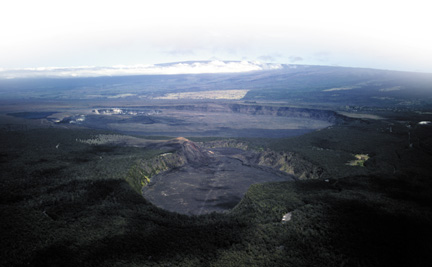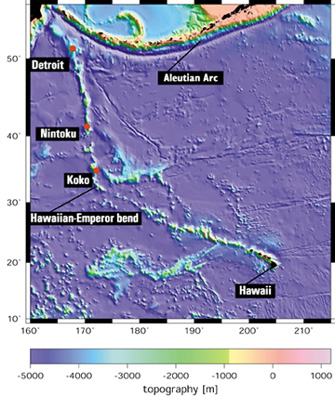
Geotimes Home | AGI Home | Information Services | Geoscience Education | Public Policy | Programs | Publications | Careers

 It started last May:
Mauna Loa, the world’s biggest volcano, began to swell amidst a swarm of
deep earthquakes beneath its summit. After 18 years of quiet, the giant appeared
to be waking. At about the same time, neighboring Kilauea, which had been inflating
slowly for months, turned up the volume on an eruption that has flowed nearly
continuously since 1983. In the so-called Mother’s Day event in 2002, a new
vent broke out on the volcano’s southeast flank, and lava output jumped to
30 times the previous average flow. Now, geologists say the two volcanoes, long
viewed as solo acts, may commune with each other beneath Earth’s surface.
It started last May:
Mauna Loa, the world’s biggest volcano, began to swell amidst a swarm of
deep earthquakes beneath its summit. After 18 years of quiet, the giant appeared
to be waking. At about the same time, neighboring Kilauea, which had been inflating
slowly for months, turned up the volume on an eruption that has flowed nearly
continuously since 1983. In the so-called Mother’s Day event in 2002, a new
vent broke out on the volcano’s southeast flank, and lava output jumped to
30 times the previous average flow. Now, geologists say the two volcanoes, long
viewed as solo acts, may commune with each other beneath Earth’s surface.
 New
results from last year’s Ocean Drilling Program (ODP) Leg 197 are suggesting
that the Hawaiian-Emperor bend may be the result of motion not of the plate, but
of the hotspot. Paleolatitude data from the Detroit, Nintoku and Koko seamounts
show that they did not form at 19 degrees north.
New
results from last year’s Ocean Drilling Program (ODP) Leg 197 are suggesting
that the Hawaiian-Emperor bend may be the result of motion not of the plate, but
of the hotspot. Paleolatitude data from the Detroit, Nintoku and Koko seamounts
show that they did not form at 19 degrees north.  |
Geotimes Home | AGI Home | Information Services | Geoscience Education | Public Policy | Programs | Publications | Careers |